2007 FORD SUPER DUTY trailer
[x] Cancel search: trailerPage 3 of 72
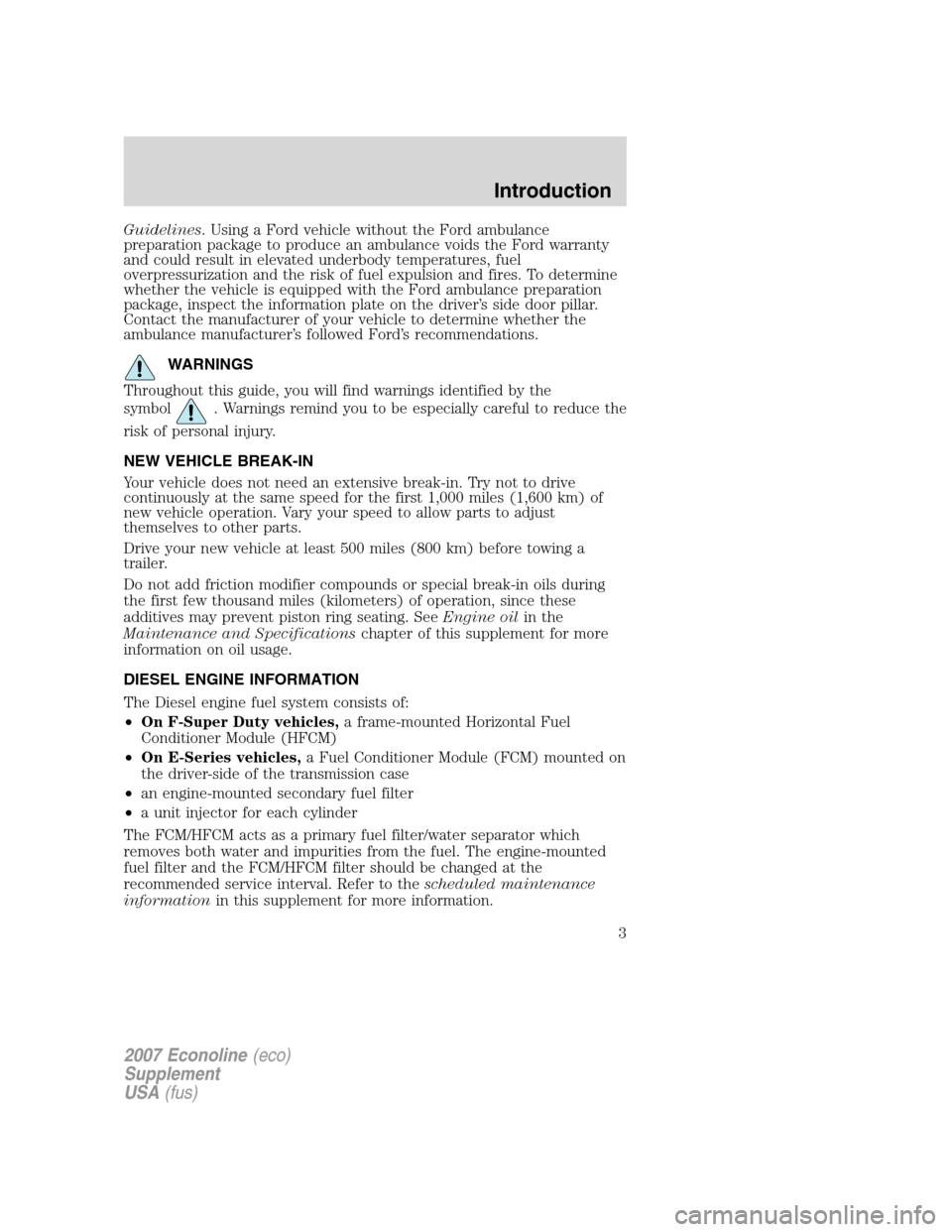
Guidelines. Using a Ford vehicle without the Ford ambulance
preparation package to produce an ambulance voids the Ford warranty
and could result in elevated underbody temperatures, fuel
overpressurization and the risk of fuel expulsion and fires. To determine
whether the vehicle is equipped with the Ford ambulance preparation
package, inspect the information plate on the driver’s side door pillar.
Contact the manufacturer of your vehicle to determine whether the
ambulance manufacturer’s followed Ford’s recommendations.
WARNINGS
Throughout this guide, you will find warnings identified by the
symbol
. Warnings remind you to be especially careful to reduce the
risk of personal injury.
NEW VEHICLE BREAK-IN
Your vehicle does not need an extensive break-in. Try not to drive
continuously at the same speed for the first 1,000 miles (1,600 km) of
new vehicle operation. Vary your speed to allow parts to adjust
themselves to other parts.
Drive your new vehicle at least 500 miles (800 km) before towing a
trailer.
Do not add friction modifier compounds or special break-in oils during
the first few thousand miles (kilometers) of operation, since these
additives may prevent piston ring seating. SeeEngine oilin the
Maintenance and Specificationschapter of this supplement for more
information on oil usage.
DIESEL ENGINE INFORMATION
The Diesel engine fuel system consists of:
•On F-Super Duty vehicles,a frame-mounted Horizontal Fuel
Conditioner Module (HFCM)
•On E-Series vehicles,a Fuel Conditioner Module (FCM) mounted on
the driver-side of the transmission case
•an engine-mounted secondary fuel filter
•a unit injector for each cylinder
The FCM/HFCM acts as a primary fuel filter/water separator which
removes both water and impurities from the fuel. The engine-mounted
fuel filter and the FCM/HFCM filter should be changed at the
recommended service interval. Refer to thescheduled maintenance
informationin this supplement for more information.
2007 Econoline(eco)
Supplement
USA(fus)
Introduction
3
Page 16 of 72
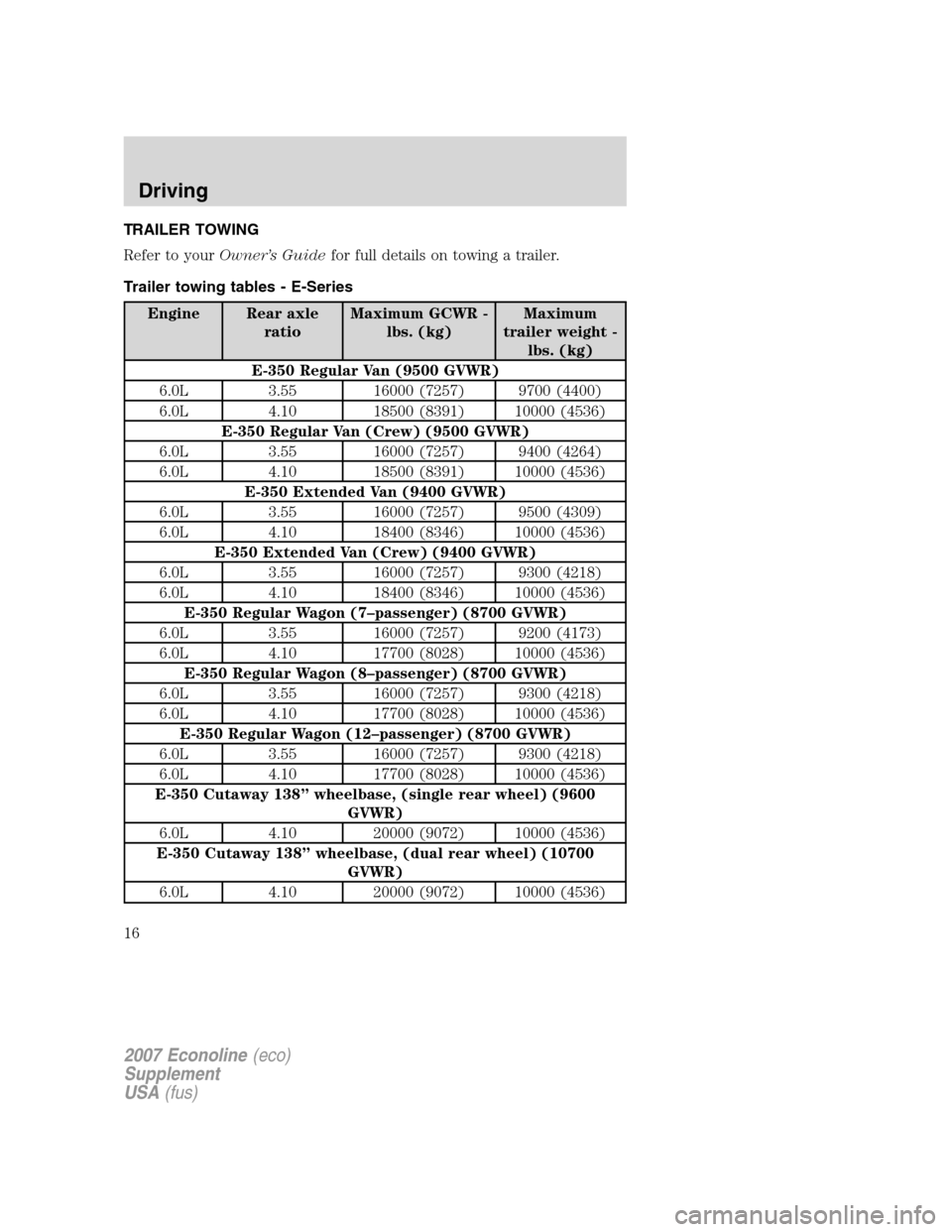
TRAILER TOWING
Refer to yourOwner’s Guidefor full details on towing a trailer.
Trailer towing tables - E-Series
Engine Rear axle
ratioMaximum GCWR -
lbs. (kg)Maximum
trailer weight -
lbs. (kg)
E-350 Regular Van (9500 GVWR)
6.0L 3.55 16000 (7257) 9700 (4400)
6.0L 4.10 18500 (8391) 10000 (4536)
E-350 Regular Van (Crew) (9500 GVWR)
6.0L 3.55 16000 (7257) 9400 (4264)
6.0L 4.10 18500 (8391) 10000 (4536)
E-350 Extended Van (9400 GVWR)
6.0L 3.55 16000 (7257) 9500 (4309)
6.0L 4.10 18400 (8346) 10000 (4536)
E-350 Extended Van (Crew) (9400 GVWR)
6.0L 3.55 16000 (7257) 9300 (4218)
6.0L 4.10 18400 (8346) 10000 (4536)
E-350 Regular Wagon (7–passenger) (8700 GVWR)
6.0L 3.55 16000 (7257) 9200 (4173)
6.0L 4.10 17700 (8028) 10000 (4536)
E-350 Regular Wagon (8–passenger) (8700 GVWR)
6.0L 3.55 16000 (7257) 9300 (4218)
6.0L 4.10 17700 (8028) 10000 (4536)
E-350 Regular Wagon (12–passenger) (8700 GVWR)
6.0L 3.55 16000 (7257) 9300 (4218)
6.0L 4.10 17700 (8028) 10000 (4536)
E-350 Cutaway 138” wheelbase, (single rear wheel) (9600
GVWR)
6.0L 4.10 20000 (9072) 10000 (4536)
E-350 Cutaway 138” wheelbase, (dual rear wheel) (10700
GVWR)
6.0L 4.10 20000 (9072) 10000 (4536)
2007 Econoline(eco)
Supplement
USA(fus)
Driving
16
Page 17 of 72
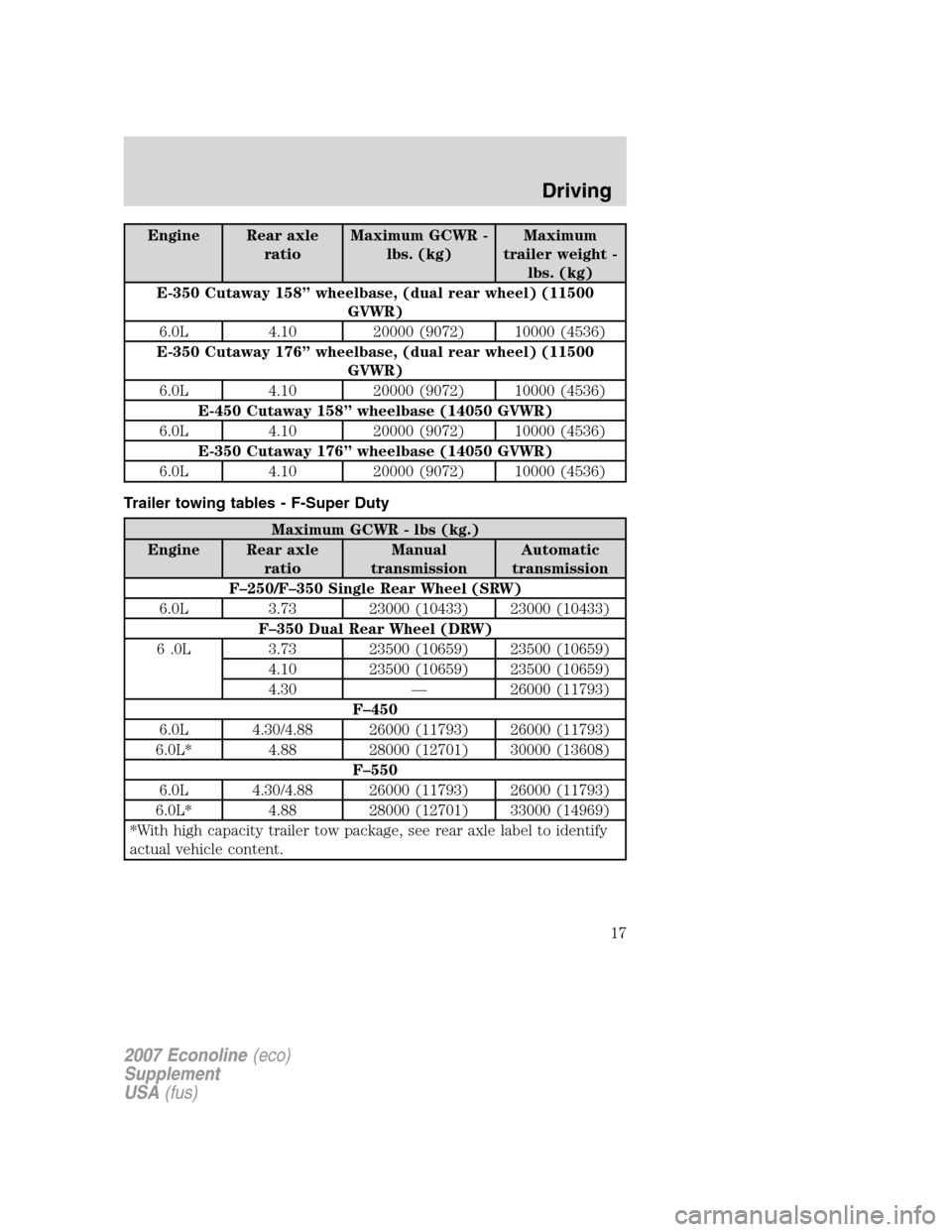
Engine Rear axle
ratioMaximum GCWR -
lbs. (kg)Maximum
trailer weight -
lbs. (kg)
E-350 Cutaway 158” wheelbase, (dual rear wheel) (11500
GVWR)
6.0L 4.10 20000 (9072) 10000 (4536)
E-350 Cutaway 176” wheelbase, (dual rear wheel) (11500
GVWR)
6.0L 4.10 20000 (9072) 10000 (4536)
E-450 Cutaway 158” wheelbase (14050 GVWR)
6.0L 4.10 20000 (9072) 10000 (4536)
E-350 Cutaway 176” wheelbase (14050 GVWR)
6.0L 4.10 20000 (9072) 10000 (4536)
Trailer towing tables - F-Super Duty
Maximum GCWR - lbs (kg.)
Engine Rear axle
ratioManual
transmissionAutomatic
transmission
F–250/F–350 Single Rear Wheel (SRW)
6.0L 3.73 23000 (10433) 23000 (10433)
F–350 Dual Rear Wheel (DRW)
6 .0L 3.73 23500 (10659) 23500 (10659)
4.10 23500 (10659) 23500 (10659)
4.30 — 26000 (11793)
F–450
6.0L 4.30/4.88 26000 (11793) 26000 (11793)
6.0L* 4.88 28000 (12701) 30000 (13608)
F–550
6.0L 4.30/4.88 26000 (11793) 26000 (11793)
6.0L* 4.88 28000 (12701) 33000 (14969)
*With high capacity trailer tow package, see rear axle label to identify
actual vehicle content.
2007 Econoline(eco)
Supplement
USA(fus)
Driving
17
Page 18 of 72
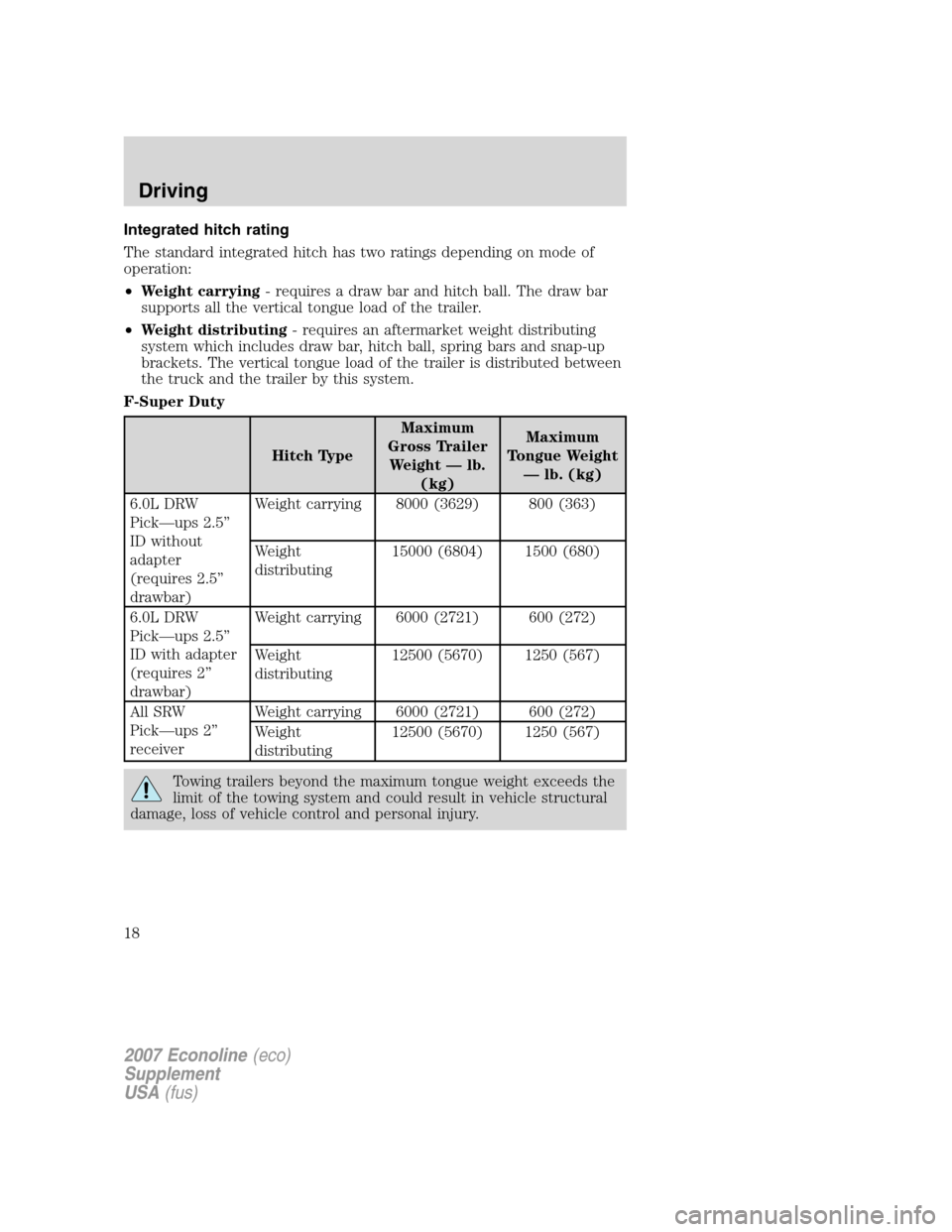
Integrated hitch rating
The standard integrated hitch has two ratings depending on mode of
operation:
•Weight carrying- requires a draw bar and hitch ball. The draw bar
supports all the vertical tongue load of the trailer.
•Weight distributing- requires an aftermarket weight distributing
system which includes draw bar, hitch ball, spring bars and snap-up
brackets. The vertical tongue load of the trailer is distributed between
the truck and the trailer by this system.
F-Super Duty
Hitch TypeMaximum
Gross Trailer
Weight — lb.
(kg)Maximum
Tongue Weight
— lb. (kg)
6.0L DRW
Pick—ups 2.5”
ID without
adapter
(requires 2.5”
drawbar)Weight carrying 8000 (3629) 800 (363)
Weight
distributing15000 (6804) 1500 (680)
6.0L DRW
Pick—ups 2.5”
ID with adapter
(requires 2”
drawbar)Weight carrying 6000 (2721) 600 (272)
Weight
distributing12500 (5670) 1250 (567)
All SRW
Pick—ups 2”
receiverWeight carrying 6000 (2721) 600 (272)
Weight
distributing12500 (5670) 1250 (567)
Towing trailers beyond the maximum tongue weight exceeds the
limit of the towing system and could result in vehicle structural
damage, loss of vehicle control and personal injury.
2007 Econoline(eco)
Supplement
USA(fus)
Driving
18
Page 38 of 72
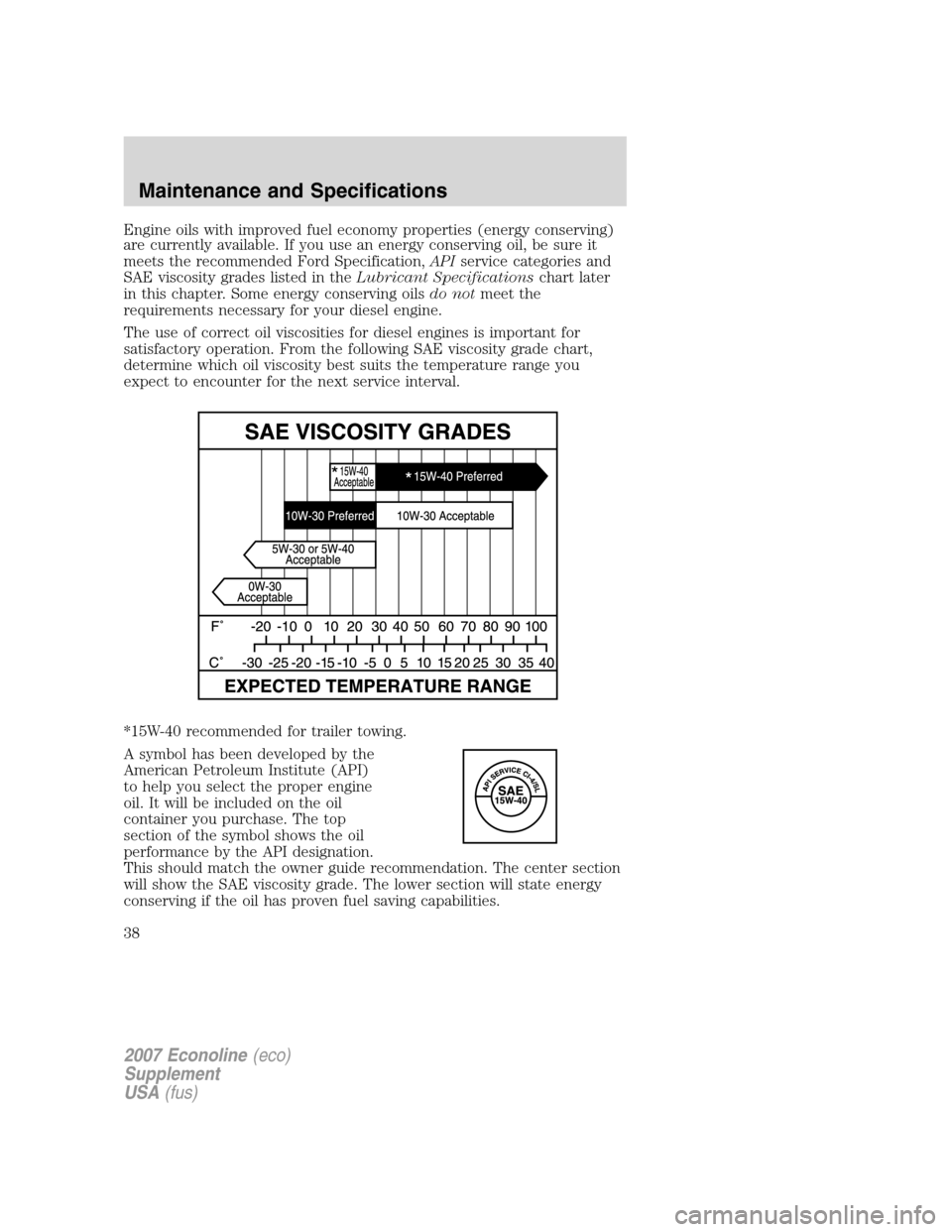
Engine oils with improved fuel economy properties (energy conserving)
are currently available. If you use an energy conserving oil, be sure it
meets the recommended Ford Specification,APIservice categories and
SAE viscosity grades listed in theLubricant Specificationschart later
in this chapter. Some energy conserving oilsdo notmeet the
requirements necessary for your diesel engine.
The use of correct oil viscosities for diesel engines is important for
satisfactory operation. From the following SAE viscosity grade chart,
determine which oil viscosity best suits the temperature range you
expect to encounter for the next service interval.
*15W-40 recommended for trailer towing.
A symbol has been developed by the
American Petroleum Institute (API)
to help you select the proper engine
oil. It will be included on the oil
container you purchase. The top
section of the symbol shows the oil
performance by the API designation.
This should match the owner guide recommendation. The center section
will show the SAE viscosity grade. The lower section will state energy
conserving if the oil has proven fuel saving capabilities.
2007 Econoline(eco)
Supplement
USA(fus)
Maintenance and Specifications
38
Page 39 of 72
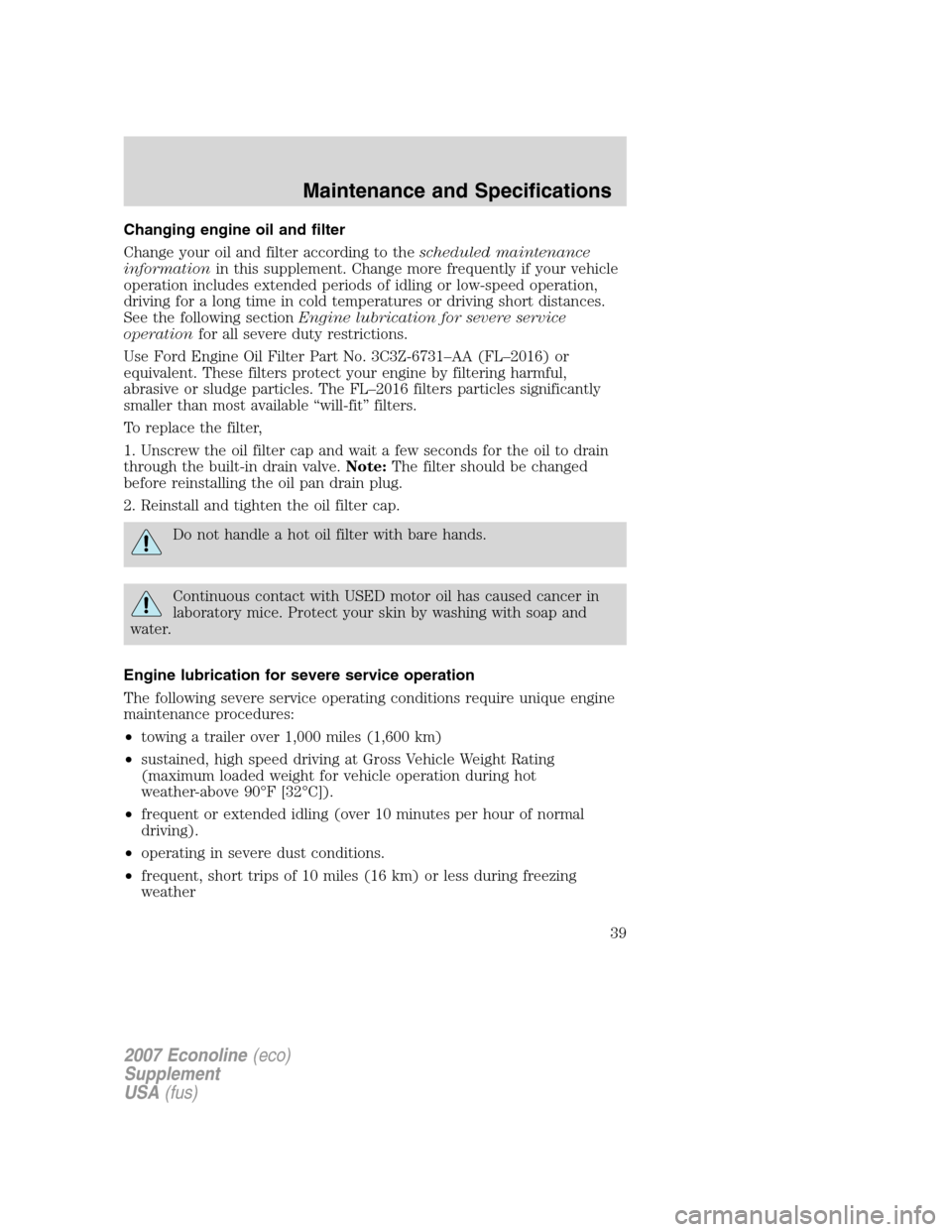
Changing engine oil and filter
Change your oil and filter according to thescheduled maintenance
informationin this supplement. Change more frequently if your vehicle
operation includes extended periods of idling or low-speed operation,
driving for a long time in cold temperatures or driving short distances.
See the following sectionEngine lubrication for severe service
operationfor all severe duty restrictions.
Use Ford Engine Oil Filter Part No. 3C3Z-6731–AA (FL–2016) or
equivalent. These filters protect your engine by filtering harmful,
abrasive or sludge particles. The FL–2016 filters particles significantly
smaller than most available “will-fit” filters.
To replace the filter,
1. Unscrew the oil filter cap and wait a few seconds for the oil to drain
through the built-in drain valve.Note:The filter should be changed
before reinstalling the oil pan drain plug.
2. Reinstall and tighten the oil filter cap.
Do not handle a hot oil filter with bare hands.
Continuous contact with USED motor oil has caused cancer in
laboratory mice. Protect your skin by washing with soap and
water.
Engine lubrication for severe service operation
The following severe service operating conditions require unique engine
maintenance procedures:
•towing a trailer over 1,000 miles (1,600 km)
•sustained, high speed driving at Gross Vehicle Weight Rating
(maximum loaded weight for vehicle operation during hot
weather-above 90°F [32°C]).
•frequent or extended idling (over 10 minutes per hour of normal
driving).
•operating in severe dust conditions.
•frequent, short trips of 10 miles (16 km) or less during freezing
weather
2007 Econoline(eco)
Supplement
USA(fus)
Maintenance and Specifications
39
Page 46 of 72
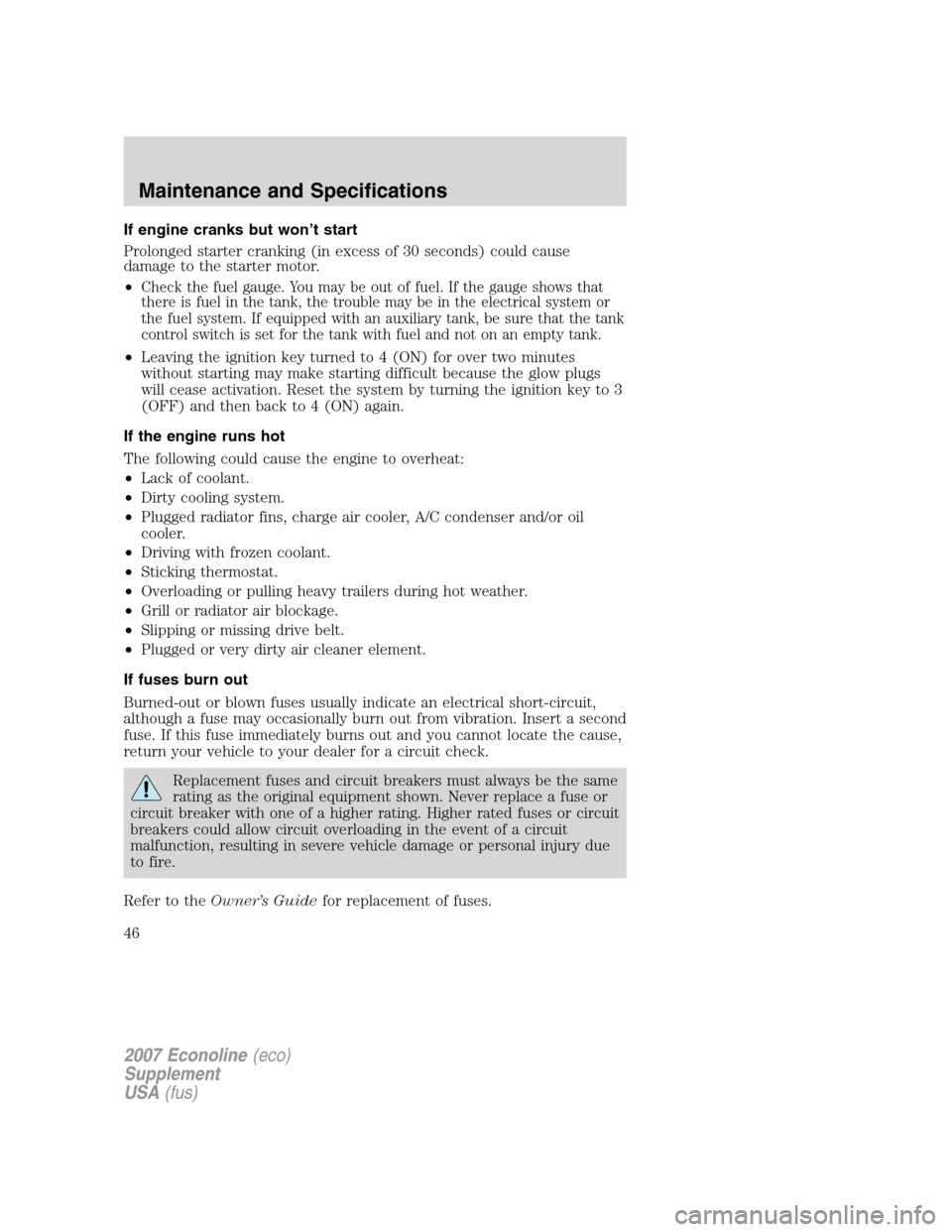
If engine cranks but won’t start
Prolonged starter cranking (in excess of 30 seconds) could cause
damage to the starter motor.
•
Check the fuel gauge. You may be out of fuel. If the gauge shows that
there is fuel in the tank, the trouble may be in the electrical system or
the fuel system. If equipped with an auxiliary tank, be sure that the tank
control switch is set for the tank with fuel and not on an empty tank.
•Leaving the ignition key turned to 4 (ON) for over two minutes
without starting may make starting difficult because the glow plugs
will cease activation. Reset the system by turning the ignition key to 3
(OFF) and then back to 4 (ON) again.
If the engine runs hot
The following could cause the engine to overheat:
•Lack of coolant.
•Dirty cooling system.
•Plugged radiator fins, charge air cooler, A/C condenser and/or oil
cooler.
•Driving with frozen coolant.
•Sticking thermostat.
•Overloading or pulling heavy trailers during hot weather.
•Grill or radiator air blockage.
•Slipping or missing drive belt.
•Plugged or very dirty air cleaner element.
If fuses burn out
Burned-out or blown fuses usually indicate an electrical short-circuit,
although a fuse may occasionally burn out from vibration. Insert a second
fuse. If this fuse immediately burns out and you cannot locate the cause,
return your vehicle to your dealer for a circuit check.
Replacement fuses and circuit breakers must always be the same
rating as the original equipment shown. Never replace a fuse or
circuit breaker with one of a higher rating. Higher rated fuses or circuit
breakers could allow circuit overloading in the event of a circuit
malfunction, resulting in severe vehicle damage or personal injury due
to fire.
Refer to theOwner’s Guidefor replacement of fuses.
2007 Econoline(eco)
Supplement
USA(fus)
Maintenance and Specifications
46
Page 62 of 72
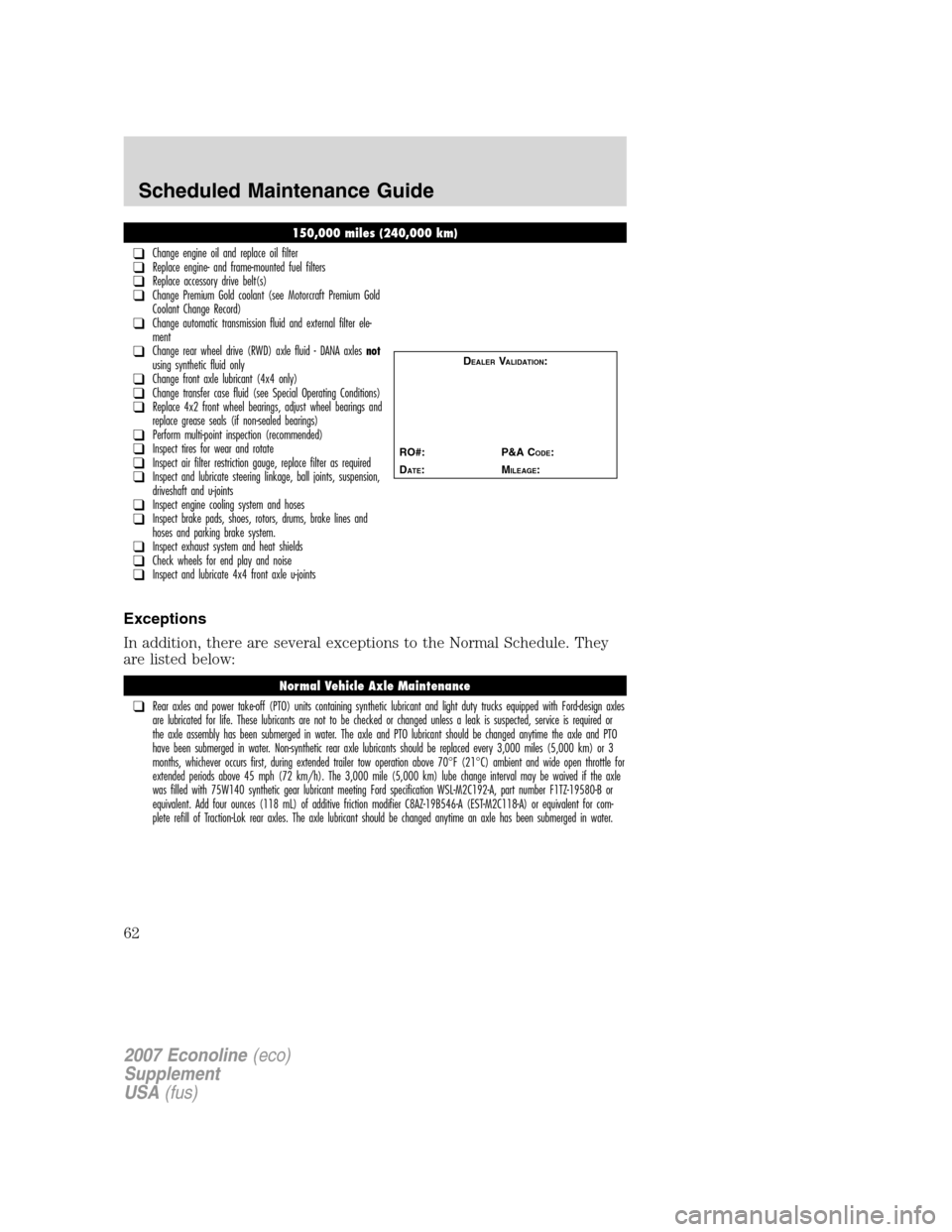
Exceptions
In addition, there are several exceptions to the Normal Schedule. They
are listed below:
150,000 miles (240,000 km)
❑Change engine oil and replace oil filter❑Replace engine- and frame-mounted fuel filters❑Replace accessory drive belt(s)❑Change Premium Gold coolant (see Motorcraft Premium Gold
Coolant Change Record)
❑Change automatic transmission fluid and external filter ele-
ment
❑Change rear wheel drive (RWD) axle fluid - DANA axlesnot
using synthetic fluid only
❑Change front axle lubricant (4x4 only)❑Change transfer case fluid (see Special Operating Conditions)❑Replace 4x2 front wheel bearings, adjust wheel bearings and
replace grease seals (if non-sealed bearings)
❑Perform multi-point inspection (recommended)❑Inspect tires for wear and rotate❑Inspect air filter restriction gauge, replace filter as required❑Inspect and lubricate steering linkage, ball joints, suspension,
driveshaft and u-joints
❑Inspect engine cooling system and hoses❑Inspect brake pads, shoes, rotors, drums, brake lines and
hoses and parking brake system.
❑Inspect exhaust system and heat shields❑Check wheels for end play and noise❑Inspect and lubricate 4x4 front axle u-joints
DEALERVALIDATION:
RO#: P&A C
ODE:
D
ATE:MILEAGE:
Normal Vehicle Axle Maintenance
❑Rear axles and power take-off (PTO) units containing synthetic lubricant and light duty trucks equipped with Ford-design axles
are lubricated for life. These lubricants are not to be checked or changed unless a leak is suspected, service is required or
the axle assembly has been submerged in water. The axle and PTO lubricant should be changed anytime the axle and PTO
have been submerged in water. Non-synthetic rear axle lubricants should be replaced every 3,000 miles (5,000 km) or 3
months, whichever occurs first, during extended trailer tow operation above 70°F (21°C) ambient and wide open throttle for
extended periods above 45 mph (72 km/h). The 3,000 mile (5,000 km) lube change interval may be waived if the axle
was filled with 75W140 synthetic gear lubricant meeting Ford specification WSL-M2C192-A, part number F1TZ-19580-B or
equivalent. Add four ounces (118 mL) of additive friction modifier C8AZ-19B546-A (EST-M2C118-A) or equivalent for com-
plete refill of Traction-Lok rear axles. The axle lubricant should be changed anytime an axle has been submerged in water.
2007 Econoline(eco)
Supplement
USA(fus)
Scheduled Maintenance Guide
62